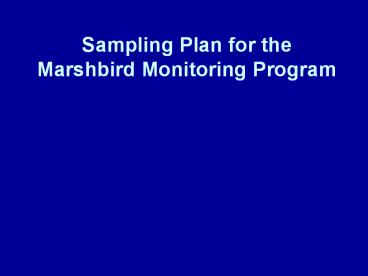Sampling Plan for the Marshbird Monitoring Program - PowerPoint PPT Presentation
1 / 22
Title:
Sampling Plan for the Marshbird Monitoring Program
Description:
Shorebirds. Waterbirds. Waterfowl. State. Number known to be ... Migrating Shorebird. Secretive Marshbird. Ground-based waterbird. Aerial Water-fowl. Survey ... – PowerPoint PPT presentation
Number of Views:34
Avg rating:3.0/5.0
Title: Sampling Plan for the Marshbird Monitoring Program
1
Sampling Plan for the Marshbird Monitoring Program
2
Constraints Requirements
- Plan must be habitat-based
- Sampling intensity will vary
- Many areas will not be accessible
- Habitat locations will change
- Consistency with plans for other groups
- Plan must be practical
3
Proposed Plan
- Delineate regions
- Identify designated areas in each region (they
comprise the target population for the region) - Describe each area
- Group designated areas into strata
- Select survey locations in each stratum
- Prepare sampling plans for each stratum
4
Bird Conservation Sub-regions
5
Identify Designated Areas
1984 DAs 641 important to secretive marshbirds
6
Describe Each Area
- Guidelines for preparing aquatic site
descriptions (PIF Symposium) - Contents
- Boundaries and ownership
- Focal species using the site and timing of use
- Location of good and fair habitat within the site
- Access to the good and fair habitat and
visibility - Past and current surveys
- Potential survey methods
- Needed pilot studies
- gt200 descriptions done
7
Prepare BCS Sampling Plan
- ID the DAs that have any of the focal species
- Form strata, each of which will be surveyed
- Prepare sampling plans for each stratum
8
Example
- BCS has 1 NWR, 6 WMAs, an area of playa lakes, 10
small wetlands each of which is a DA, an area of
low density birds.
Strata DAs Strata DAs
1 NWR 5 6 wetlands
2 3 WMAs 6 the playas
3 3 WMAs 7 low density area
4 4 wetlands
9
NWI Coverage
10
Sampling Plans Within Strata
11
Guidelines for Sampling Plans
- Target population must be well-defined (e.g, so
its size can be calculated) - Can include only good habitat or not
- Can change between (or within) years
- Suggest distributing evenly (stations or
clusters)
12
Implications for Database Design
- Value exists in designing the database for many
different groups. - Can have 5 spatial, and 4 temporal, levels, so
need up to 9 (or 10) level sampling - Need size and number of sub-units for each unit
at each level - This information must be in the database
- We are developing one to hold it for regional
use. I know of no others. - With 10-stage sample, and variable sized units at
each level, analysis will be complex using either
survey sampling or mixed models.
13
Example of Implementation
14
(No Transcript)
15
Number of areas Number known to be important for Number known to be important for Number known to be important for
State Number of areas Waterfowl Waterbirds Shorebirds
Arizona 42 15 32 13
California 40 20 22 19
Colorado 44 0 29 22
Idaho 52 7 32 4
Montana 21 2 12 13
Nevada 48 15 20 2
New Mexico 37 9 20 12
Oregon 40 30 28 13
Utah 41 17 27 20
Washington 18 7 4 3
Wyoming 41 23 1 0
All 424 145 227 121
16
State Prepared Not prepared Proportion prepared
Arizona 0 42 0.00
California 0 40 0.00
Colorado 17 27 0.39
Idaho 50 2 0.96
Montana 15 6 0.71
Nevada 25 23 0.52
New Mexico 0 37 0.00
Oregon 0 40 0.00
Utah 30 11 0.73
Washington 0 18 0.00
Wyoming 0 41 0.00
Grand Total 137 268 0.34
17
Survey Aerial Water-fowl Ground-based waterbird Secretive Marshbird Migrating Shorebird Breeding Colonies All surveys
Existing survey 117 119 44 29 79 388
No survey at present 28 112 73 93 64 370
Volunteers could conduct 7 30 40 30 34 141
Volunteers could help 0 13 4 5 4 26
Staff would conduct 0 46 23 42 24 135
Survey would be difficult 21 23 6 16 2 68
Information lacking 263 191 293 276 242 1265
- 44 secretive marshbird surveys at present
- Opportunities for 73 more
- Volunteers could do 40 of them
- Staff would need to help or do all of 27 surveys
- Only 6 would be difficult
18
Reports IWCBM Overview, Progress Report,
Aquatic Bird Survey, Terrestrial Bird Survey,
Data Management System, Analytic Tools, others
19
Major Obstacles
- Getting data contributed
- Getting surveyors, especially for low density
areas
Non-Obstacles
Designing sampling plans (once labor available
and practical constraints are known)
20
Roles and Responsibilities
- USGS Oversight, design, web site
- IWJV - Implementation
- Don Paul UT, NV, CA
- Dan Casey MT, ID, WY
- Bob Vahle NM, AZ, CO
- Joe Latourette WA
- Bruce OR
- WWG Forum for decisions
- States, NWRs, Bd. Obs. Conduct surveys
21
Next Steps
- Review DAs
- Encourage prepn of area descriptions
- Hold meetings to consider which sites can be
surveyed - Design BCS and strata sampling plans
- Select survey locations in every stratum
- Recruit surveyors for as many as possible
- Finish web site data base
- Work on analytic methods
22
Summary and Conclusions
- Comprehensive plan now developed
- I believe plan is flexible and practical enough,
but independent review needed. - Easy to carry out with other surveys.
- Need more people trying to use it, especially at
the BCS level and in new habitats (e.g., coastal
marshes) - No databases exist to hold all the data
- Developing analytic methods will be non-trivial.































